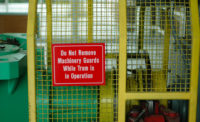2019 top standards- OSHA Most Frequently Violated Standards
OSHA machine guarding standard
OSHA’s machine guarding standard was the ninth-most-frequently cited agency standard in FY 2018.

Enforcement citations FY 2018: 1,700
Number of inspections: 1,567
Proposed penalties: $10,407,511
Most frequently cited industries
- Manufacturing
- Wholesale trade
- Retail trade
- Services
- Waste management and remediation
- Accommodation and food services
- Public administration
Enforcement case study
On January 24, 2018, OSHA cited Supplyside USA, a pallet manufacturer, for machine safety violations after an employee was injured while conducting maintenance on equipment. The company faces $91,832 in proposed penalties for two repeated, six serious, and three other-than-serious violations.
OSHA inspectors found Supplyside USA, which operates as Prime Woodcraft Inc., failed to install adequate machine guards, implement energy control procedures to prevent equipment from unintentional operation, and train workers about noise hazards; and allowed combustible dust to accumulate on surfaces.
“Too often, employees are injured because companies lack adequate machine safety procedures and safeguards,” said OSHA Chicago South Area Office Director Kathy Webb. “Employers have a responsibility to evaluate their workplaces for hazards, and ensure safe operations.”
Fatality case study
OSHA’s Denver Regional Office reported a fatality caused by the installation of transparent replacement guarding material having a lower impact resistance than the manufacturer's original guard for the machine.
The fatality involved the use of plexiglass as the machine guarding window for a lathe. The fatality occurred when the bell casting on a lathe became loose while the lathe was turning and subsequently struck an employee in the head and neck as he was looking through the window. The bell casting was propelled through two, 1/2 -inch-thick plexiglass material windows. The plexiglass material windows were installed as a replacement for the manufacturer's original composite window on the machine's door frame.
The manufacturer's original observation window was made of a 1/4-inch-thick laminated glass plate with a 1/2-inch-thick polycarbonate window, separated by an approximately 1/4-inch air space. The original window was replaced with plexiglass material that had a lower impact resistance than the polycarbonate shield originally supplied by the machine manufacturer.
Various polycarbonates have different impact-resistance characteristics for different thicknesses and/or surface areas. It is important to note that increasing the thickness beyond a certain level does not always improve or increase the impact resistance characteristics.
Replacement machine guard windows must meet or exceed the manufacturer's original design specifications.
When replacing original equipment parts, OSHA recommended employers review the specifications and ensure that the specifications of replacement materials meet or exceed the original design specifications.
Background
Moving machine parts have the potential to cause severe workplace injuries, such as crushed fingers or hands, amputations, burns, or blindness. Safeguards are essential for protecting workers from these preventable injuries. Any machine part, function, or process that may cause injury must be safeguarded. When operation of a machine or accidental contact injures the operator or others in the vicinity, the hazards must be eliminated or controlled.
Hazard protection
Amputations occur to fingers, hands, feet and other body parts, mostly through compression, crushing, or by getting caught between or struck by objects. Most amputations involve fingertips. Employers must workers protect from amputation hazards through adequate guarding and employee training.
Machine safeguarding is the best way to prevent amputations. Guards provide physical barriers to hazardous areas. They should be secure and strong, and workers should not be able to by-pass, remove or tamper with them. Guards should not obstruct the operator’s view or prevent others from working.
Devices help prevent contact with points of operation and may replace or supplement guards. Devices can interrupt the normal cycle of the machine when the operator’s hands are at the point of operation
Key Machine Guard standard takeaways
- The standard covers woodworking machinery, abrasive wheel machinery, mechanical power presses, and other specific machinery. For the construction industry, the standard covers hand tools, power-operated hand tools, abrasive wheels and tools, woodworking tools, jacks-lever and ratchet, screw and hydraulic, air receivers and mechanical power-transmission apparatus
- Types of guarding. One or more methods of machine guarding shall be provided to protect the operator and other employees in the machine area from hazards such as those created by point of operation, ingoing nip points, rotating parts, flying chips and sparks. Examples of guarding methods are-barrier guards, two-hand tripping devices, electronic safety devices, etc.
- General requirements for machine guards. Guards shall be affixed to the machine where possible and secured elsewhere if for any reason attachment to the machine is not possible. The guard shall be such that it does not offer an accident hazard in itself.
- Point of operation guarding. Point of operation is the area on a machine where work is actually performed upon the material being processed.
The point of operation for machines whose operation exposes an employee to injury shall be guarded. The guarding device shall be in conformity with any appropriate standards therefor, or, in the absence of applicable specific standards, shall be so designed and constructed as to prevent the operator from having any part of his body in the danger zone during the operating cycle.
Special hand tools for placing and removing material shall be such as to permit easy handling of material without the operator placing a hand in the danger zone. Such tools shall not be in lieu of other guarding required by this section, but can only be used to supplement protection provided.
The following are some of the machines which usually require point of operation guarding:
- Guillotine cutters
- Shears
- Alligator shears
- Power presses
- Milling machines
- Power saws
- Pointers
- Portable power tools
- Forming rolls and calendars
- Revolving drums, barrels, and containers shall be guarded by an enclosure which is interlocked with the drive mechanism, so that the barrel, drum, or container cannot revolve unless the guard enclosure is in place.
- When the periphery of the blades of a fan is less than seven (7) feet above the floor or working level, the blades shall be guarded. The guard shall have openings no larger than one-half (1/2) inch.
- Machines designed for a fixed location shall be securely anchored to prevent walking or moving.
Compliance resources
The following references aid in recognizing hazards from ineffective machine guarding.
- Machine Guarding. OSHA eTool. Focuses on recognizing and controlling common amputation hazards associated with the operation and use of certain types of machines.
- Machine Guarding: Horizontal Injection-Molding Machines - Interactive Safety Tour. Allows user to take a virtual tour of an injection-molding machine.
- Amputations. OSHA Fact Sheet, (2002). Provides a general overview of amputations in the workplace.
- Potential Hazards Associated with the Use of Replacement Materials for Machine Guarding (PDF). OSHA Hazard Information Bulletin (HIB). Clarifies that replacement machine guard windows must meet or exceed the manufacturer's original design specifications.
- 29 CFR 1910.217(g) Mechanical Power Press Point of Operation Injury Reports: 8/1994-12/2000. OSHA. Summarizes "point of operation" injuries from mechanical power presses.
Sponsor:
800-298-2066
Looking for a reprint of this article?
From high-res PDFs to custom plaques, order your copy today!





